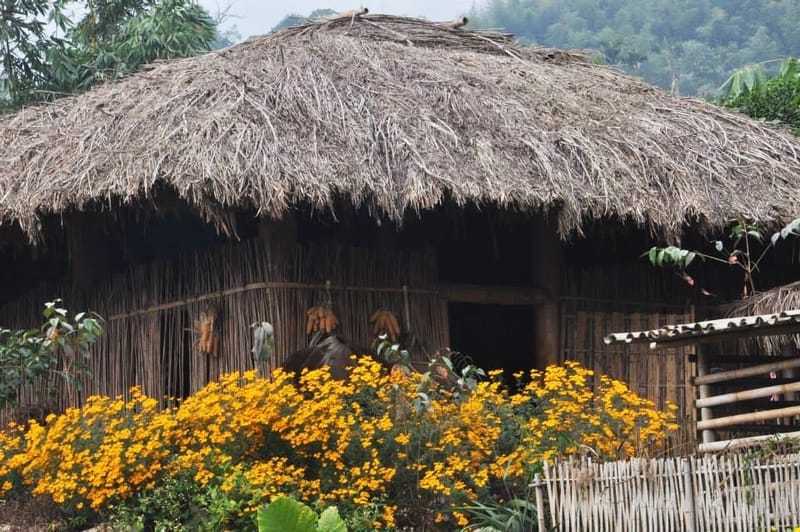Tsou Traditional House

Traditional Homes of Tsou’s custom lifestyle
1) Basic concept of Tsou’s family Homes
Tsou’s organizational level of relatives is clear, divided into three levels: family, lineage and clan group.
Ongko no emoo (lineage group) is the basic social structure unit of Tsou. A group of Ongko no emoowho live together have two feature, they share the “taboo house” (Emoo no peisia), and animal’s skeleton shelf (Tvofsuya or hufu) as their symbol. Their feature are farming together, sharing river fishing area, holding millet rituals together.
The unit consisted of lineage group called family (Cono suizopu), and created by family homes (Emoo), and thus the member that separate from homes.
The clan (Aulu macocono aemana) which combine of Onko no emo build a bigger relatives group. Their kinship is very clear and is a exogamous, and sharing the hunting place and arable land
From these clan constitute a tribe. Their level organization of relatives clearly, we can clearly understand from the following picture.
Alishan Tsou had forty-three lineage group (Ongko no emoo), belonging to eight clans (Aulu macocono aemana). The population of clan distribute migrate at each agency, so the population and status of the lineage are different.
Since ancient habit, the people of the clan is living together, a whole clan as normal living unit, until they expanding dominion, facilitating their jobs, living unit gradually reduced, patriarchal clan earlier now the trend became patriarchal family. Nowadays the family’s members had two forms, one is a family system include grandfather, father, brother, uncle relationship; another is a small family system include a couple and child relationships.
2) Picture of the designated place when guide touring inside home
3) Position of guide tour and the point of explanation
Picture 1-6 represent position tour explanations, the guiding point following:
1. Tsou’s traditional homes is Tsou’s the smallest unit of the most perfect society basic structure (Cono suizopu) (family). In ancient times, regardless of population size, all living in this type of homes without reference to the number, share a storage for sacrifice the goddess of millet and an animal’s skeleton shelf as living taboo.
Front door (cungsu): In traditional concept, the female is prohibited to enter. The main reason is female could not touching the wall of the right side that holding the equipment of fighting and hunting.
Back door (miacmo’na): The entrance of the female and their working tool was putting at this area.
Silent: Inside the family homes cannot making too much noise, to avoid disturb the goddess of millet. The degree of rigor even drive the dogs out of the homes, also can’t loudly ordered expelled.
2. Exhibition of war and the hunting tools: All the hunting tools prohibited the touching of the female, please advised the guest don’t touching.
Tosvafou(卸下獵物輔助臺):This is the place where the hunter put down their capture of the hunting when they came back, and put the prey onto the Tosvafou dismembering and share to the each family.
Boar skull(Yasngu no fuzu):Tsou used to store the hunted animals head bone on animal’s skeleton shelf, its main significance to highlighting the hunting harvest, and also can be used as instruct orally of the hunting skill, the hunter would taught the next generation how to hunting and explaining the skill. Therefore, the display of the bone skull not only boar, and also covered the deer, Formosa sambar deer, muntiacus reevesi, hawk claw, goat horn and others.
Fire Place(Pupuzu): At left and right side each have one , on the left is mainly used to roast meat, millet, leather and other else(Show: the way to set up the grill). Right side of the fireplace is used for cooking. The first layer above the fireplace placed bamboo frame to put the general tableware, next to it hanging basket (Kubana) to put the leftover meat. The second layer placed a wooden stored the dryness millet, the top line is wrapped with vine placed leather or meat. (p.s. hanging overhead is said to be afraid of children eating).
3. “indoor lean knee squatting burial”.
Steam Box (Fuheonga): Steaming glutinous rice, millet, as important tools for making glutinous rice cake (Ufi)
Bed (Hopo/mohcungcu): According to the members of the family living in added the bed, sometimes will use lahapu (weaven mats made by shell ginger leaf) carpet on the floor as bed, so the number of the bed uncertain.
4. Variety of sieve trays (knitting material: yellow rattan, bamboo, shell ginger leaf).
Escape door (tungkuyu): When enemy comes, rational logic inevitably offensive attack by forward and backward, but Tsou’s homes had a unique escape door can be used as the key to winning the enemy; similarly like incorporated into the vat by encirclement wipe out.
Pestle (pngiei) Mortal (sugngu): Tools of making glutinous rice cake and millet wine, is one of the main female, is said to the female not play millet never been married.
This area displayed the tools that female commonly used, so deliberately put at back door (miacmo’na). After the wall hung the female work outside farming equipment.
Rubbing skin of Rattan Shelf (eyaaso): Tsou consumes in Taiwan aboriginal is very outstanding, it had obviously leather wearing, leather hats, leather pants leggings, shawls…. Tsou put the dried or drying animals skins hanging on the rubbing skin of rattan shelf and rub back and forth, until the leather becomes soft and wearable.
Warehouse Sacrifice millet (Emoo no peisia): The place goddess of millet staying, and also is place stored millet, this cabinet is a very important symbol of the spirit of home, and also constitute a reason of taboo of traditional family home. Family home strictly to be silent to avoid disturbed goddess of millet and to be punished.
5. This area is female come in and go out, so the wall hanging the most female working appliance use.
Small hoe (tu’u): purposes of farming.
Back basket (yungku): to load the harvest and carrying it.
Basket carrying wood (mongnu): the wood as timber collecting from the mountain put into the basket and bear to home.
6. Here is introducing about Tsou fishing
Pavilion of share (Fo’fo): Its purpose is to distribute, cook, eat the fish, it’s prohibited to eat the fish at home, only finished at Fo’fo, and they must wash their hands, gargle before entering the home.
Fishing frame (yungu): This appliance is generally set up at the rapids river, the water flow guide into the frame, and fall into the rear of piper lane.
Harpoon (teezo): more commonly used in the dry winter period, the river visually and directly piercing with the harpoon.
Fishing net (yoi no maaseu): At the summer rainy season, use the fishing net caught the fish when the river without vision.
Coop (emoo no teo’ua): The backyard of home will fence coop depends of demand; or masonry walls as fencing to breed pigs.


